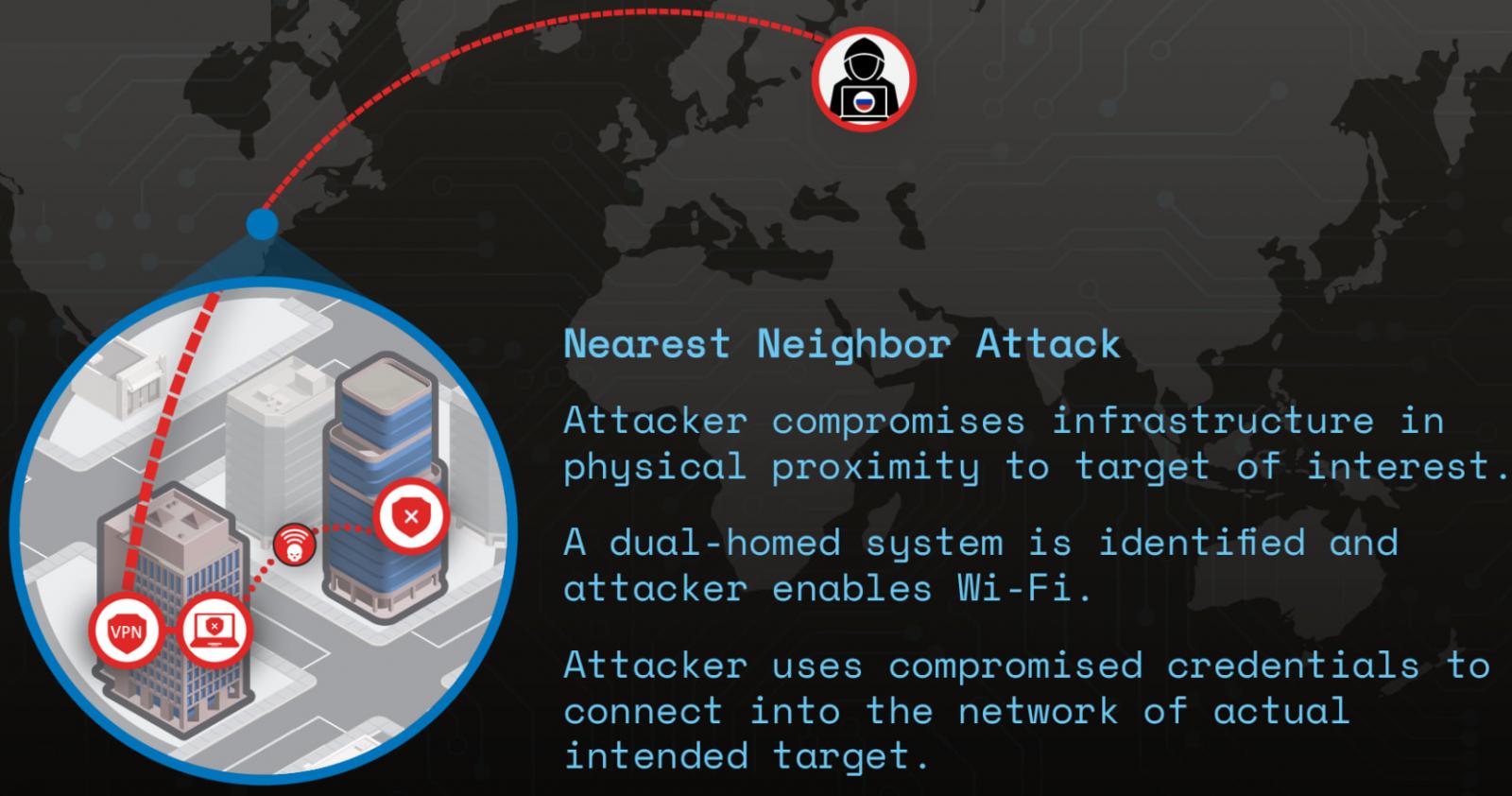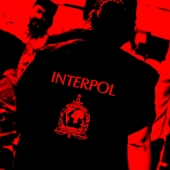APT28's "nearby neighbor attack" shows that a close-access operation, which typically requires proximity to the target (e.g. parking lot), can also be conducted from afar and eliminates the risk of being physically identified or caught.
Hackers breach US firm over Wi-Fi from Russia in 'Nearest Neighbor Attack'
Bill Toulas
- November 22, 2024
- 02:33 PM
- 1

The threat actor pivoted to the target after first compromising an organization in a nearby building within the WiFi range.
The attack was discovered on February 4, 2022, when cybersecurity company Volexity detected a server compromise at a customer site in Washington, DC that was doing Ukrainian-related work.
The hackers, which Volexity tracks as GruesomeLarch, first obtained the credentials to the target's enterprise WiFi network through password-spraying attacks targeting a victim's public-facing service.
However, the presence of multi-factor authentication (MFA) protection prevented the use of the credentials over the public web.
- Although connecting through the enterprise WiFi did not require MFA, being "thousands of miles away and an ocean apart from the victim" was a problem.

Using a remote desktop connection (RDP) from an unprivileged account, the threat actor was able to move laterally on the target network searching for systems of interest and to exfiltrate data.
The hackers ran servtask.bat to dump Windows registry hives (SAM, Security, and System), compressing them into a ZIP archive for exfiltration.
- The attackers generally relied on native Windows tools to keep their footprint to a minimum while collecting the data.
"Volexity further determined that GruesomeLarch was actively targeting Organization A in order to collect data from individuals with expertise on and projects actively involving Ukraine" - Volexity
- Based on details in Microsoft's report, it's very likely that APT28 was able to escalate privileges before running critical payloads by exploiting as a zero day the CVE-2022-38028 vulnerability in the Windows Print Spooler service within the victim's network.
While internet-facing devices have benefited from improved security over the past years, by adding MFA and other types of protections, WiFi corporate networks need to be treated with the same care as any other remote access service.
-
Over 1,000 arrested in massive ‘Serengeti’ anti-cybercrime operation
Law enforcement agencies in Africa arrested as part of 'Operation Serengeti' more than a thousand individuals suspected of being involved in major cybercriminal activities that caused close to $193 million in financial losses all over the world.
- November 26, 2024
- 02:13 PM
 0
0
-
Study for multiple CompTIA certifications with this $25 course bundle deal
If you want a more affordable way to study, check out the Ultimate Cybersecurity and IT Career Certification Training Bundle. This CompTIA prep bundle comes with 169 hours of lessons on multiple CompTIA certifications instead of buying separate prep bundles for each exam. And for Black Friday, the price dropped to $24.97 (from $184).
- November 26, 2024
- 02:06 PM
 0
0
-
Sponsored Content

Get a Free shadow SaaS inventory + security insightsDiscover all SaaS accounts ever created by anyone in your org, in minutes, along with insights on security risks and spend. Save time, money and effort by curbing SaaS sprawl and automating tasks like offboarding and user access reviews. Free trial.
- Security· Sponsored Content
Why Cybersecurity Leaders Trust the MITRE ATT&CK Evaluations
The "MITRE Engenuity ATT&CK Evaluations: Enterprise" stand out as an essential resource for cybersecurity decision makers. Learn more from Cynet on what to expect in the upcoming 2024 MITRE ATT&CK Evaluation results.
- November 26, 2024
- 10:01 AM
 0
0
-
Hackers exploit critical bug in Array Networks SSL VPN products
America's cyber defense agency has received evidence of hackers actively exploiting a remote code execution vulnerability in SSL VPN products Array Networks AG and vxAG ArrayOS.
- November 26, 2024
- 08:26 AM
 0
0
-
Firefox and Windows zero-days exploited by Russian RomCom hackers
Russian-based RomCom cybercrime group chained two zero-day vulnerabilities in recent attacks targeting Firefox and Tor Browser users across Europe and North America.
- November 26, 2024
- 07:13 AM
 2
2
-
Black Friday is your chance to get lifetime access to Rosetta Stone
A Rosetta Stone lifetime subscription gives you the time and guidance to follow your linguistic dreams, and Black Friday just dropped the price even further. For a limited time only, you can get a Rosetta Stone lifetime subscription for $148.97 (reg. $399).
- November 26, 2024
- 07:11 AM
 0
0
-
QNAP addresses critical flaws across NAS, router software
QNAP has released security bulletins over the weekend, which address multiple vulnerabilities, including three critical severity flaws that users should address as soon as possible.
- November 25, 2024
- 05:13 PM
 0
0
-
New Windows 10 0x80073CFA fix requires installing WinAppSDK 3 times
Microsoft has shared a new method to fix a bug preventing app uninstalls or updates on Windows 10 for those unwilling to deploy this month's preview update.
- November 25, 2024
- 04:57 PM
 0
0
-
Need to upskill on a budget? Don't miss this Black Friday deal
The Ultimate Lifetime Bundle of StackSkills, Infosec4TC, and Stone River combines three robust learning platforms into a powerhouse toolkit for professional growth, and lifetime access just got marked down to $109.97 (reg. $480).
- November 25, 2024
- 04:15 PM
 0
0
-
Blue Yonder ransomware attack disrupts grocery store supply chain
Supply chain management firm Blue Yonder is warning that a ransomware attack caused significant disruption to its services, with the outages impacting grocery store chains in the UK.
- November 25, 2024
- 04:11 PM
 1
1
-
DOJ: Man hacked networks to pitch cybersecurity services
A Kansas City man has been indicted for allegedly hacking into computer networks and using this access to promote his cybersecurity services.
- November 25, 2024
- 02:24 PM
 1
1
-
Microsoft blocks Windows 11 24H2 on some PCs with USB scanners
Microsoft now blocks the Windows 11 24H2 update on computers with standalone scanners, multi-function printers, fax machines, modems, and other network devices with eSCL protocol support.
- November 25, 2024
- 12:28 PM
 0
0
-
Salt Typhoon hackers backdoor telcos with new GhostSpider malware
The Chinese state-sponsored hacking group Salt Typhoon has been observed utilizing a new "GhostSpider" backdoor in attacks against telecommunication service providers.
- November 25, 2024
- 11:12 AM
 0
0
-
Microsoft 365 outage impacts Exchange Online, Teams, Sharepoint
Microsoft is working on fixing an ongoing and widespread Microsoft 365 outage that is impacting multiple services and features, including Exchange Online, Microsoft Teams, and SharePoint Online.
- November 25, 2024
- 10:55 AM
 0
0
-
Get 1TB of portable storage in this Black Friday deal
Don't miss this 1TB Dual USB-C + USB-A 3.2 High-Speed Flash Drive while it's on sale for Black Friday for just $69.97 (regularly $109) with free shipping—only through December 8 at 11:59 p.m. PT.
- November 25, 2024
- 07:12 AM
 0
0
-
Meta removes over 2 million accounts pushing pig butchering scams
Meta announced that it has taken down 2 million accounts across its platforms since the beginning of the year that are linked to pig butchering and other scams.
- November 24, 2024
- 11:19 AM
 4
4
-
Bangkok busts SMS Blaster sending 1 million scam texts from a van
The Thai police, working together with Thailand's largest telecommunications service provider, Advanced Info Service (AIS), located and busted the Chinese operators of an SMS blaster device that spammed fraudulent messages across Bangkok.
- November 24, 2024
- 10:09 AM
 0
0




















No comments:
Post a Comment